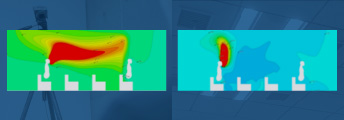Research Fields
- Concrete Materials
- Soil and Ground
- Rock and Groundwater
- Civil-Engineering Structures
- Marine Hydraulics
Concrete Materials
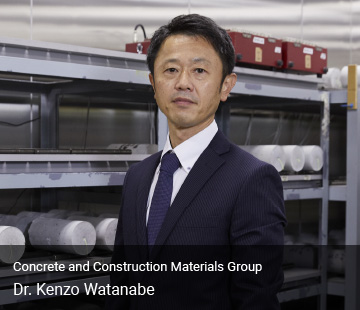
Improve quality of concrete structures and
productivity of concrete works
To build a safe and secure society, concrete structures, which are the foundation of society, must be highly durable. And to cope with the aging of construction workers and the decrease in their numbers, the productivity of concrete construction must be increased. On top of those requirements, in response to global warming, “environmental load-reducing concrete” —which reduces CO2 emissions—is attracting attention. We are working to solve these issues on the basis of the high-performance and multifunctional concrete technologies that we have developed in conjunction with extensive construction experience.
Research Cases
Excellent durability and strength through fiber reinforcement
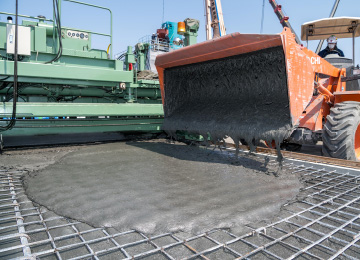
Ultra-high-performance fiber-reinforced cement-based composite “UHPFRC”
Improving surface quality of concrete structures
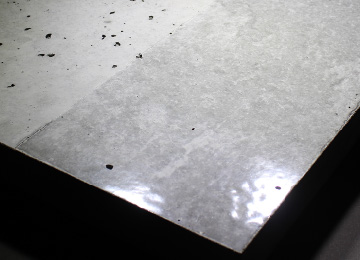
Curing technology for improving surface quality: “Utsuku (Beautiful) Seal Curing Method”
Absorbs and fixes large amounts of CO2 in the same way as trees do
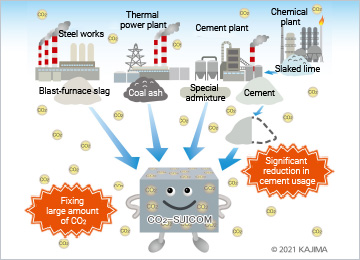
CO2-absorbing concrete “CO2-SUICOM”
Related Information
Soil and Ground
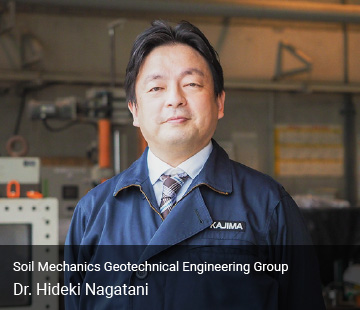
Contributing to the construction of resilient infrastructure through advanced ground-related technologies
Safely and efficiently building infrastructure in a wide range of areas—from mountainous regions to urban areas and above ground to underground—necessitates advanced ground-related technology. Moreover, future demand for labor-saving construction will only grow.
To meet these needs, we are researching and developing technologies for automating earthworks, technologies for visualizing the underground during tunnel construction, and geological-disaster-prevention technologies such as liquefaction countermeasures.
Research Cases
Tracking ground movement during construction in real time
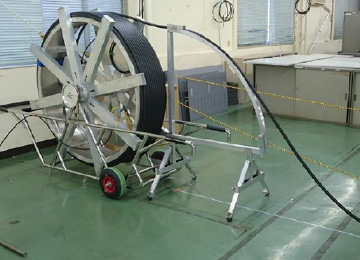
Distributed-optical-fiber underground-visualization technology
Strengthening the ground to enable safe underground construction
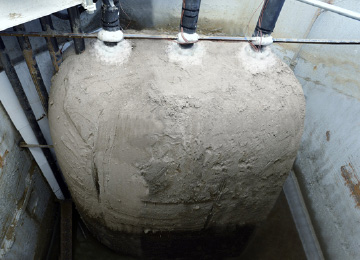
Ground-freezing technology (construction, predictive analysis, and frozen-soil testing) *Ground-freezing technology provided by Chemical Grout Co., Ltd.
High-speed, full-surface scanning of embankment quality
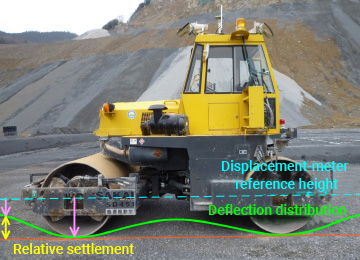
Compaction-management technology “Roller-deflection method”
Rock and Groundwater
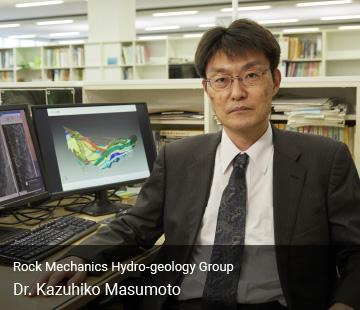
Improving productivity at tunnel sites and improving quality of groundwater evaluation and measurement management
In construction fields such as tunnels, dams, large holes, and nuclear power-related facilities, it is becoming necessary to improve productivity by promoting automation and mechanization. As for tunnel construction, we aim to avoid construction delays by eliminating collapse and deformation during construction and, ultimately, improve productivity. We are using cutting-edge ICT, centered on Kajima’s own database, to develop technologies that aim for zero accidents and problems. As for dam-foundation work, we are developing rational injection-management methods by building models based on construction information. We are also developing technologies related to the geological disposal of high-level radioactive waste as a form of technology development that contributes to the SDGs.
Research Cases
Visualize geology in real time by using ICT to prevent collapse of the tunnel face
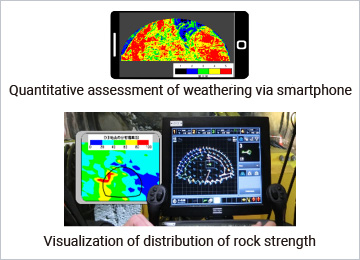
“Smart Face Watcher”
High-density measurement of tunnel support stresses around the entire circumference of the tunnel by using optical fibers to select the optimum support
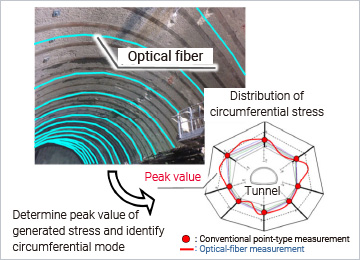
High-speed, high-precision measurement of tunnel support stress by using distributed optical fibers
Modeling of water-conducting fractures in bedrock for rational injection management of dam-foundation work
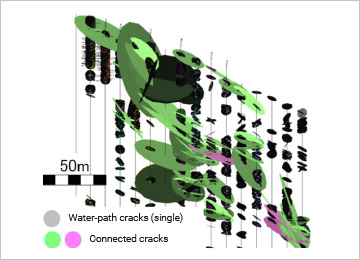
3D construction-quality-control system for dam-foundation work
Civil-engineering Structures
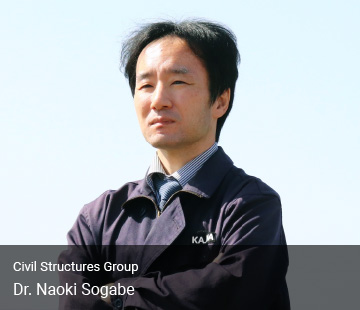
Improve productivity at construction sites and
renew aging infrastructure
Future development of social infrastructure will require technology for building high-quality structures quickly and with fewer people. Technology for renewing aging social infrastructure while it is still in use as well as technology for installing sensors in structures to detect deterioration at an early stage and extend the lifespan of structures through appropriate repairs will also be required.
To satisfy those requirements, we are researching and developing high-productivity construction technologies that utilize concrete, steel, and composite structures, renewal technologies that utilize the properties of high-performance materials, and performance-evaluation technologies for structures that incorporate cutting-edge sensors.
Research Cases
Lightweight and highly durable PCa slabs make it easy to replace deteriorated slabs
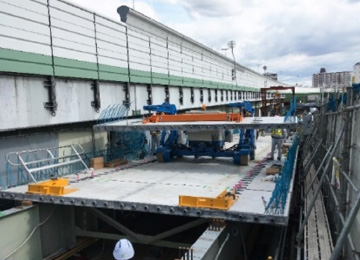
Flat UFC slabs (ultra-high-strength fiber-reinforced concrete)
Significantly reduce installation time for cast-in-place piles
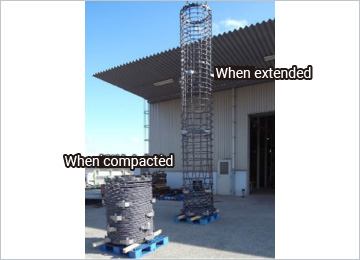
“Strand place pile-driving method” using an expandable rebar cage
Reliable management of tension in PC structures
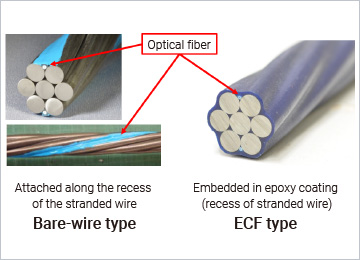
PC-tension measurement system using optical fiber
Marine Hydraulics
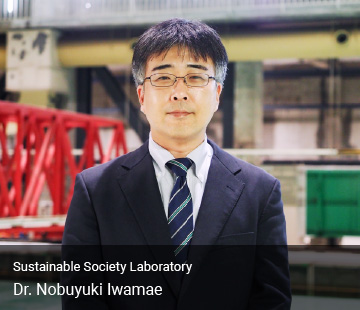
Offshore and river facilities are safely constructed
with high productivity.
Offshore wind-power facilities are expected to be a renewable energy source; however, constructing them requires wave-resistant structures that can handle high waves, construction plans, and measures to prevent corrosion. Moreover, coastal facilities require measures to reduce damage from tsunamis, while river construction requires construction plans that minimize the impact on water levels and the environment.
To satisfy these requirements, we are researching and developing safe hydraulic structures by using marine and hydraulic experimental facilities, various numerical-simulation technologies, and on-site measurement technologies.
Research Cases
Evaluating vibrations during transportation of foundations for offshore wind-power generation facilities and taking measures to prevent corrosion
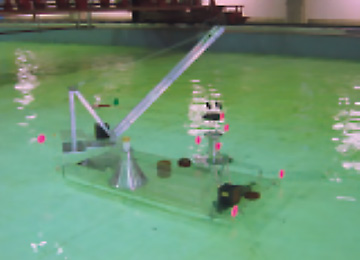
Technology for evaluating the vibrations of work vessels
Assessing tsunami wave forces acting on structures through hydraulic model experiments
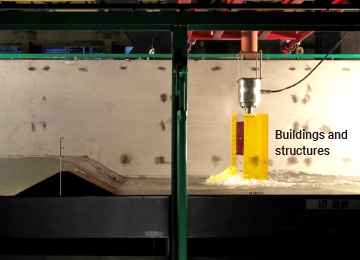
Technology for evaluating tsunami wave force
Numerical wave tank for evaluating wave deformation and wave force from detailed shape data of structures
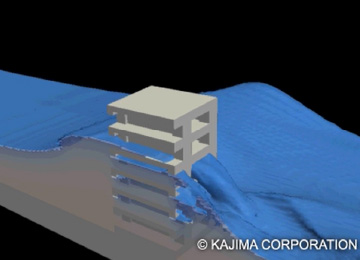
Numerical wave tank
Pick Up Technologies
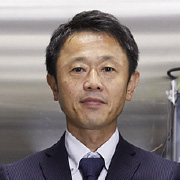
Concrete for 100 years
Utsuku (Beautiful) Seal Curing Method

Construction management automation technology useful for ensuring quality
Total concrete volume acceptance management system using video analysis
Building Materials

Ensuring quality by utilizing materials and construction technologies that reflect various needs
Considering the construction sites of the near future, we are researching and developing ICT-based concrete-pouring management systems, AI-based estimation of concrete compressive strength, improvement of productivity by using floor-finishing robot technology, environmental consideration through CO2 reduction and effective use of by-products, globalization, and building maintenance and preservation-oriented material construction. Specifically, in the field of construction using reinforced-concrete (RC) material, our research includes concrete incorporating powdered blast-furnace slag in accordance with the concepts of environmental friendliness, high quality, and cost-effectiveness as well as technology for estimating the compressive strength of concrete during acceptance inspection at construction sites. In the field of finishing materials, our research includes technology for quantitatively evaluating the quality and lifespan of materials such as tiles, coating materials, and waterproofing materials as well as technology for maintaining air quality and combating mold caused by building materials.
Research Cases
Reduce CO2 with environmentally friendly concrete

Three types of concrete made with powdered blast-furnace slag
Evaluating quality of concrete during acceptance inspection

Estimating compressive strength of fresh concrete by using electrical conductivity
Rapidly evaluate weather resistance of coating materials

Kajima’s own method for estimating service life of exterior coating materials
Building Structure

Improve structural performance of buildings and productivity at construction sites
Technologies for evaluating and improving the performance of architectural structures during long-period seismic motion or extremely large earthquakes, like the Tohoku Pacific Coast Earthquake and the Kumamoto Earthquake, are needed. Moreover, as the construction of skyscrapers continues, mainly in metropolitan areas, technologies to streamline construction and improve productivity and quality are also needed. To meet these needs, we are researching and developing (i) technologies for evaluating building performance experimentally and analytically, (ii) repair and reinforcement technologies for improving building performance, and (iii) highly productive structural technologies for steel structures, reinforced-concrete structures, composite structures, underground structures, foundation structures, and others. We are also verifying building safety by reproducing building shaking using a large shaking table (called W-DECKER) and researching and developing wooden structures toward a zero-carbon future.
Research Cases
FR Wood makes it possible to build new fire-resistant wooden buildings of “visible wood”

Pure wood fire-resistant laminated lumber (FR Wood: fire-resistant wood)
Our large-scale shaking table reproduces massive earthquakes, and our long-period shaking table reproduces the shaking of high-rise buildings.

High-performance 3D shaking table (W-DECKER)
Evaluating structural performance of architectural structures by using nonlinear finite element method (FEM)

Nonlinear-analysis program “CARC-ASe”
Building Environment

Construction of a building environment, including factors such as acoustics, vibration, heating and cooling, energy conservation, equipment, and lighting
To build a future “sustainable society,” energy-saving buildings such as ZEB (zero-energy buildings) are required. Also, it is necessary to improve the quality of the indoor environment in buildings such as offices, production facilities, and medical facilities. To meet these needs, we are researching and developing a wide range of indoor environments, including factors such as acoustics, heating, lighting, and energy conservation. In recent years, we have also been researching and developing “wellness-conscious” indoor spaces, which meet the need to create not only such environments but also spaces that are comfortable and healthy for the people who spend time in them and promote high intellectual productivity.
Research Cases
Provide a space for promoting wellness

SOTOBEYA (Outdoor Room)
Build your own 3D sound system and apply it to architectural spaces

3D sound by OPSODIS
Detailed understanding of air flow around windows, temperature distribution, etc.

Airflow-visualization experiment
Architectural Planning

Exploring rational architectural-planning methods suited to human behavior and psychology
We live in an age in which buildings that consider “the quality for the user,” through universal design, for example, are needed. To meet that need, we are researching to (i) support circulation planning, scale planning, and design planning by organizing the correspondence between human behavioral requirements and spatial performance and (ii) communicate the design intentions and reasons to clients in an easy-to-understand manner. We are also researching and developing topics such as behavioral surveys, questionnaire analysis, and evaluation of plan proposals in offices, hospitals, and educational facilities, behavior monitoring and data analysis of space users, behavioral simulations to evaluate user movements in planned spaces, and impression evaluations using VR. In recent years, we have also been taking the challenge to make spaces smarter using IoT and AI technologies.
Research Cases
Measuring pedestrian trajectories in architectural spaces and understanding behavioral characteristics

Behavior monitoring using laser radar
Predict pedestrian behavior in a planned space and evaluate validity of traffic-flow plans

Office simulation using multiple agents
Measure the subject’s gaze in a VR space and evaluate the appeal of the approach space

Impression evaluation using eye-mark recorder
Pick Up Technologies

Sensuous wellness space
SOTOBEYA (Outdoor Room)

Achieving 3D sound for multiple listeners simultaneously
OPSODIS Stereophonic Sound
Biodiversity and Greening

Providing high value-added spaces for people by integrating the diverse functions of living organisms and the natural environment with construction technology
Our lives depend on the blessings we receive from mother nature. For a sustainable society, it is essential to maintain harmony with the “water,” “greenery,” and “living organisms” that make up nature. Moreover, it is important to not only protect and nurture biodiversity and greenery but also develop social infrastructures that make the most of their functions.
We are striving to resolve issues as we move toward implementing the SDGs by utilizing our knowledge and experience to create green environments that contribute to biodiversity and implement measures to reduce the impact of construction on plants and animals.
Research Cases
Restoring and creating wetlands and waterside areas

Technology for creating a firefly biotope
Monitoring of flora and fauna and assessing their impact on ecosystems

“Ikimono Note”: animal, plant and environment monitoring system
Creating comfortable green spaces

Artificial lightweight culture soil: “K-SOIL”
Ever Cool Garden: Rooftop greening with enhanced evapotranspiration
Related Information
Biotechnology

Development of environmental purification and recycling technologies utilizing microbial functions
The global environment is deteriorating under the amount of trash, wastewater, carbon dioxide, and other matter that people produce as they live their daily lives comfortably. At Kajima, we are researching and developing technologies to utilize the power of microorganisms to minimize the negative impact of such waste on the global environment.
Two core technologies we have developed are (i) high-temperature fixed-bed methane-fermentation technology (which treats waste and wastewater while simultaneously recovering biogas, a carbon-neutral fuel) and (ii) anammox (anaerobic ammonium oxidation) technology (which can highly efficiently remove nitrogen, a cause of eutrophication, from wastewater).
Research Cases
High-temperature fixed-bed methane fermentation enables highly efficient biomass decomposition and biogasification

Fixed-bed methane-fermentation facility “Methacules”
Anammox reaction removes nitrogen at low cost but high efficiency

Highly efficient nitrogen-removal system “EDES”
Decomposes odor components by utilizing the power of microorganisms

“BADOS”: Low-running-cost biological deodorizing system
Soil purification and Waste

Through rational measures against soil contamination and effective utilization of construction waste, we contribute to decarbonization and resource circulation.
Our “Ground Environment Team” conducts research and development aimed at realizing a circular economy through measures against soil contamination identified during construction projects and effective utilization of construction waste.
Currently, we are particularly focused on in-situ and on-site remediation technologies for contaminated soil containing novel trace organic pollutants, represented by 1,4-dioxane, upcycling technologies that add value to construction waste for effective utilization, and CO2 fixation technologies using calcium-containing waste.
Research Cases
Remediation technology that uses drain materials to suction and recover contaminants

In-situ remediation technology for soil and groundwater contamination using drain methods
Thick-layered soil spraying that self-supports with a single blow

Self-supporting thick-layered soil spraying method “K-Knight Method”
Dust dispersion and erosion prevention material with biodegradability and weather resistance

Dust dispersion and erosion prevention material “MAK Former.20”
Pick Up Technologies

Surveying the habitat of fireflies from 1 liter of water
Firefly Monitoring Using Environmental DNA

Tool to realize a recycling society
Technology to generate energy from organic waste (biomass)
Seismic Motion

Advanced-input evaluation of seismic motion for
improving seismic safety
As a means of ensuring the safety of structures against future major earthquakes, it is necessary to predict the behavior of structures during earthquakes by using numerical analysis. To meet that necessity, the seismic motion that acts as an external force must be accurately evaluated. Aiming to evaluate the seismic motion at construction sites when anticipated earthquakes occur, we are developing evaluation technologies such as numerical simulations of the seismic motion transmitted from faults to construction sites and statistical evaluation of seismic motion based on earthquake observation data.
Research Cases
Using numerical calculations to predict long-period earthquake motion

Simulation of motion of long-period earthquake
Evaluating seismic motion for designing structures

Evaluation of input seismic motion
Understand seismic characteristics of the ground

Subsurface-structure model
Fire

Improving structural safety of buildings in the event of a fire and evacuation safety of occupants
In terms of protecting human life and property, fire safety for buildings is just as important as earthquake safety. To ensure that people inside buildings can evacuate safely in the event of a fire, we are researching and developing technologies to improve the structural safety of CFT (concrete-filled steel tube), steel frames, reinforced concrete, and wooden components (pillars, beams, etc.) at high temperatures as well as technologies to improve evacuation safety by precisely reproducing and predicting the movements of each individual and the effects of smoke and heat on people. These technologies are used not only in buildings but also in civil-engineering structures (shield tunnels).
Research Cases
Animation of evacuation behavior

“PSTARS”: evacuation simulator linking people, heat, and smoke
Predicting smoke and heat flow during a fire

Fire simulator “FDS”
Testing and evaluating the performance of structural and interior materials in the event of fire

Technology for evaluating fire-resistance performance
Wind

Evaluating wind effects and providing safe structures and comfortable living and wind environments
To ensure wind resistance and safety of wind-sensitive structures such as skyscrapers, large-space structures, and temporary scaffolding, we are researching evaluation of wind load on structural framing and exterior materials by using one of the largest wind tunnel facilities in the construction industry and cutting-edge numerical-simulation technology, and we reflect the results of these evaluations in design and construction. We are also researching and developing themes related to wind, such as predicting and evaluating environmental problems such as “building wind” around buildings, occupant performance associated with wind swaying in high-rise buildings, and wind noise.
Research Cases
Evaluating wind load on buildings, wind environment around buildings, and performance of occupants in buildings

Technology for measuring wind pressure and velocity through wind-tunnel experiments
Prediction and visualization of wind conditions and wind pressure around buildings

Numerical-fluid-analysis technology
Predicting wind noise and vibration noise from exterior materials

Technology for measuring wind noise and vibration noise by using wind-tunnel experiments
Business Continuity Plan (BCP)

Research and development to facilitate smooth implementation of business continuity plans (BCPs) for our own company and our customers
In recent years, owing to climate change, severe disasters are more frequent. Moreover, earthquakes that have a high probability of occurring, such as the Nankai Trough earthquake and an earthquake directly beneath Tokyo, can occur across Japan. In such a disaster-prone country, formulating a business continuity plan (BCP) is essential for companies. Our team handles a variety of BCP-related events, including not only earthquakes but also typhoons, floods, and fires. For example, we have recently been researching how to utilize information on rainfall, strong winds, heatstroke, and typhoon paths.
Research Cases
Mash-up of various hazard information, real-time damage information, and one’s own information by GIS

Disaster-information-sharing system, online hazard maps
Evaluating employee assembly time in the event of a disaster

Employee-assembly system
Predicting flooding conditions from moment to moment during heavy rains

Urban flood-prediction and analysis system
Infrastructure

Digital twin for future forecasting and operational support of infrastructure
To develop local economies and improve living environments, future infrastructure development must make effective use of “stock effects” (effects accrued over the medium to long term from the functions of infrastructure). Also, with the increasing frequency and severity of disasters, risk assessment and information provision from the perspective of disaster prevention and mitigation measures are also required.
To meet these requirements, we are promoting the digitization of infrastructure information and researching and developing “infrastructure stock-effect evaluation technology” incorporating economic-evaluation models and “wide-area, time-series evaluation technology” for multi-hazards (such as earthquakes and wind and flood damage) as well as climate change, which is the root cause of the recent increase in wind and flood damage.
Research Cases
Simulating earthquake motion at each point in a city and damage to all buildings and structures

Integrated earthquake simulator (IES)
Comprehensive analysis of storm-water runoff and discharge phenomena by simultaneously considering both external and internal flooding

Urban flood-prediction and analysis system
Understanding the benefits of infrastructure development in regard to local communities and industrial structures

Technology for evaluating stock effect of infrastructure
Pick Up Technologies

Consolidation and sharing of diverse disaster information
Disaster Information Sharing System
Turning Civil-engineering Sites into Factories

Pursuing data-based optimization and streamlining of construction processes
We are researching and developing sensing and data analysis, autonomous control, optimization technology, and other areas to solve social issues such as improving productivity amid a decline in skilled workers and improving the resilience of infrastructure that deteriorates over time.
To create “factories on site,” we will implement safe and highly productive construction through automation and autonomy of heavy machinery and digitization of construction processes and optimize construction plans through mathematical and analytical methods. We will also continue to research and develop technologies to ensure the quality of structures and streamline production management through sensing and data analysis using optical fiber and images.
Research Cases
Improve construction productivity and safety through automation of heavy machinery

Next-generation construction and production system “A4CSEL”
Detecting minute deformations in large-scale structures with high accuracy

System for measuring tension in pre-stressed concrete (PC) by using optical fiber
Optimizing heavy-machinery work routes and construction sequences

Optimization of ground-leveling routes by utilizing deep reinforcement learning
AI/Data Science

Unlocking the potential of data to solve problems and create value
We are pursuing research and development that contributes to improving safety and productivity and ensuring and improving quality by applying AI (artificial intelligence) technologies such as machine learning. In many cases, we are building systems that predict, judge, evaluate, and optimize inputs by having them learn from large amounts of accumulated numerical and image data. Currently, we are focusing on research themes such as speeding up design analysis, automating construction work, automating quality control, drafting and optimizing construction plans, and forecasting weather and ocean conditions.
Research Cases
Speeding up computationally intensive analysis of wind environment by utilizing machine-learning models

Speeding up computational fluid analysis by utilizing machine learning
Instant, highly accurate evaluation of construction quality of concrete structures from photos

Technology for evaluating concrete quality by utilizing data science
Highly accurate forecasting of waves that affect the feasibility of offshore construction and improving safety and productivity

Wave-prediction technology utilizing convolutional neural networks
Smart Production of Buildings

Reforming all production processes related to construction work and improving productivity
The environment surrounding the construction industry is expected to become more severe year by year. It is particularly important to address the shortage of construction workers and to take steps to realize work style reform. Kajima aims to build new production processes and improve productivity by proactively introducing the latest technologies, such as ICT and AI, and reforming on-site management methods through the development of robotics technology.
With those circumstances in mind, we are researching elemental technologies and developing robots to enable smart production as well as developing new tools to reform on-site management methods.
Research Cases
Power-assisted work suits make work easier

Power-assisted work suits
Automation and labor saving concerning welding work at construction sites

Articulated on-site welding robot
Streamlining management and operations regarding materials and equipment

Digitalization of information about materials and equipment
Pick Up Technologies

Construction system through autonomous operation of
construction vehicle machines
A4CSEL (“quad axel”)

Total concrete volume acceptance management system using video analysis
Construction management automation technology useful for ensuring quality

